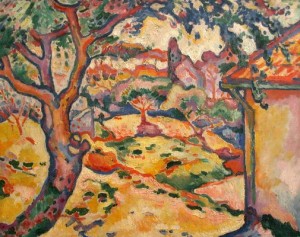MOST LIKELY, YOU HAVE READ ALL ABOUT the recent theft of five big-ticket paintings from the Paris Museum of Modern Art. If not, you can catch up here. And here. Britain’s Daily Mail does well with this sort of thing. Lots of pictures. Its online edition is one of the few sites that illustrated each of the paintings stolen: Picasso’s Pigeon with Peas, Matisse’s Le Pastorale, Braque’s Olive Tree Near Estaque, Modigliani’s Woman With a Fan and Still Life with Chandelier by Leger. You can look up the others on the Mail site, but here is the one I could cry for:

In dollar terms, it was a staggering heist worth close to a 100 million euros that looks, by all accounts, to have been a well-organized inside job.
Lovely phrase, inside job. It conjures up the entire kaleidoscope of detective fiction, all the police procedurals from the hard-boiled Twenties to the contemporary whodunits in Woody Haut’s Neon Noir. But just who on the inside? If I were a fiction writer, I would make the culprit a Muslim security guard with a sophisticated sense of jihad. Why? Two reasons. First, because the very unsaleability of the art argues against this having been pulled off for market purposes. For sure, a few generations down the line, a plausible provenance can be constructed retrospectively. But no garden variety art thief aspires to that kind of long term payback. Not that this stops speculation about economic motives for the theft. NPR’s blog Xchange quotes Clare McAndrew, a consultant on the art market:
Many top collectors are what I call hoarders. They buy and hold- have no intention of selling. So I guess if you can find someone that is interested in adding these pieces to a private collection, they are really not interested in selling it on. Of course this limits the price that they will pay, but it is a market driven by scarcity so when there are no substitutes, I think you will still see people willing to fork out large sums. There is the other notion that art is used as collateral for other illicit transactions. In a drug deal for example, you take a consignment to sell but will need to offer some security re repayment- the keys to a car, house, piece of art? Again, I don’t imagine the loan to value ratio is very high here because of its limited resale value, but it is possible that it may act as security.
So even the experts are skeptical about resale. The director of the Palais de Tokyo, Pierre Cornette de Saint-Cyr, called the thieves fools: “These five paintings are un-sellable, so thieves, sirs, you are imbeciles, now return them.” So, why would my fictional character have stolen these for money?
In my novel, the paintings would turn up being burned in a public square in, say, Tehran. It would circulate around the globe on YouTube and iPhones. The cheering ummah would be seen dancing around the Ground Zero mosque.
And why not a bonfire of Western vanities made for video? In our post-Christian era, culture itself has become an object of veneration. Yale’s Louis Dupré, writing in the late 1990s, observed that in the Judeo-Christian West, religious faith has been absorbed by culture itself. It has become just one more cultural artifact. An art theft is as close as we can come to experiencing sacrilege. And a newly confident Islam knows it.
© 2010 Maureen Mullarkey
NOTE: A few emails came asking if reference to a mosque at Ground Zero was a joke. No. On Tuesday, May 25th, a New York City community board okayed the construction of a 13-storey mosque and “cultural center.” Rod Dreher comments on it here.


